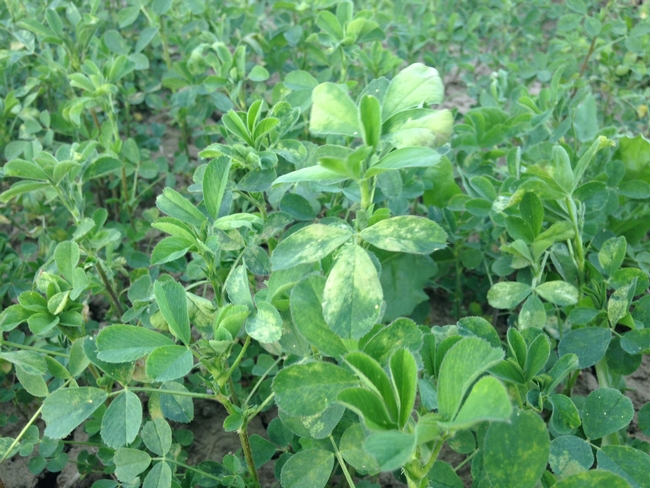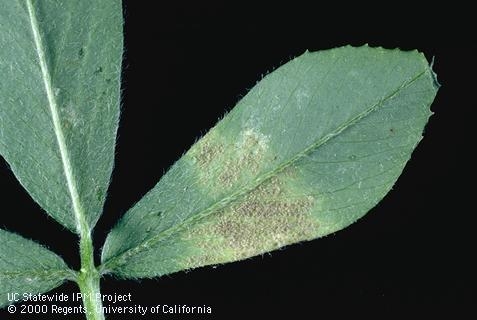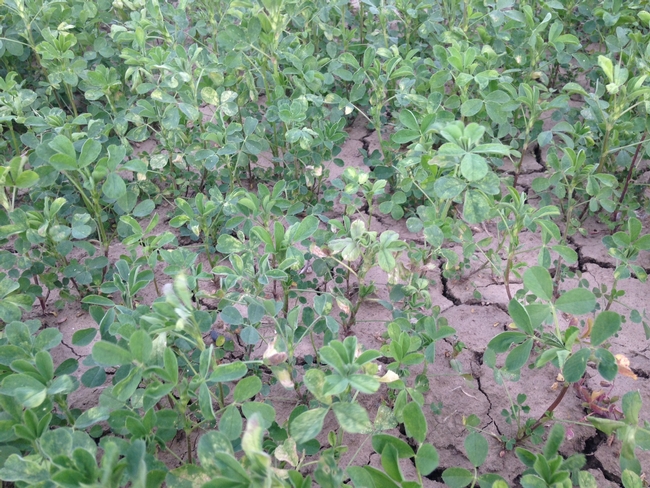By Rachael Freeman Long
Downy mildew, common on some crops but less common in alfalfa, has been observed this winter in some Sacramento Valley alfalfa fields. In young fields, heavy disease pressure could have a significant effect on first cutting yields, and perhaps even in well-established fields, but it is questionable as to whether it is worth treating.
 In plants infected with downy mildew, the upper surface of leaves become lighter in color and in some cases a mottled yellow. The undersides of leaves are often coated with a gray dust (a mass of fungal spores). Sometimes entire buds and leaves become infected, resulting in leaf distortion and a general yellowing. Infected leaves drop off the plant and can reduce yield and quality if the field is heavily infected.
In plants infected with downy mildew, the upper surface of leaves become lighter in color and in some cases a mottled yellow. The undersides of leaves are often coated with a gray dust (a mass of fungal spores). Sometimes entire buds and leaves become infected, resulting in leaf distortion and a general yellowing. Infected leaves drop off the plant and can reduce yield and quality if the field is heavily infected.
Leaves infected with downy mildew are spotted with a distinctive yellowish color.
Downy mildew is a cool season foliar disease that occurs when temperatures are cool and humidity is high enough for the pathogen to infect alfalfa. For this reason, it is rarely seen in some years, and even in wet years, it is usually only a problem for a few weeks in spring. Once the weather gets warmer and drier, the problem disappears.
There is a fairly big difference among cultivars in susceptibility to downy mildew, but since it is not something varieties are rated for it is difficult to get information on resistance levels. Additionally, it is uncertain whether the Fall Dormancy 6-9 varieties that we grow in California's Central Valley and deserts have been bred for significant resistance.

Treatment is not usually needed, as plants will outgrow the damage from downy mildew once the weather turns warm and dry. However, seedling fields are always at higher risk and should be monitored carefully to avoid plant damage. This is especially true for spring-planted fields when plants are small and weather conditions tend to be most favorable for disease development. Downy mildew does not usually threaten stand density, but it can reduce plant vigor.
Downy mildew on underside of leaves has masses of gray spore-bearing structures
If your field is young, shows heavy disease pressure from downy mildew, and has a long way to go before cutting, it may be worth treating with a fungicide such as Headline, especially if the weather is predicted to be rainy.
Otherwise, it is more likely wise to simply wait until the weather improves, and the crop is able to grow out of the infectious period.

Young alfalfa stand showing severe disease pressure from downy mildew.
Source:ucanr.edu